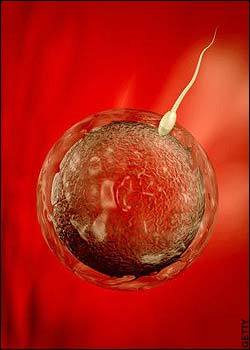When the Prime Minister walks out of the press conference, he leaves a single flake of skin on the lectern. A woman quietly picks it up, takes it to a lab and, nine months later, gives birth to his child.

|
| ©Unknown |
| "A woman could simply pick up a bit of bodily detritus, take it to a laboratory, and give birth to the genetic child of Sir Richard Branson." |
This might seem like a fantasy but is no longer beyond the bounds of possibility, according to Anna Smajdor, an ethicist at the University of East Anglia who is pondering the implications of methods under development to create eggs and sperm in the laboratory.
The direct applications seem straightforward. The creation of "artificial gametes" will help us understand how the real things are made, shedding light on the causes of infertility and raising the hope that sterile men and women could one day have biological children.
But there are other, stranger implications, which Smajdor will try to spell out at a public discussion with other experts tonight at the Centre for Life in Newcastle, organised by the Progress Educational Trust.
"If sperm and eggs can be created from stray skin cells, people's control over their reproductive choices is dramatically altered," she says. "A woman could simply pick up a bit of bodily detritus, take it to a laboratory, and give birth to the genetic child of Sir Richard Branson."
As Parliament debates changes to the 1990 Human Fertilisation and Embryology Act, the Government is under pressure to include an amendment to allow the use of eggs and sperm that have been grown in the lab from stem cells.
One clause would restrict this to sperm from genetic (XY) males and eggs from genetic (XX) females, reflecting the disquiet many feel over aspects of this reproductive revolution, notably the prospect of self-reproduction or gay couples having biological children.
"What has been termed 'reprogrammable biology' gives us the capacity to make cells act in new ways, blurring what we mean by an egg or sperm, or even embryo," says Smajdor.
"The boundaries between these categories have become very fluid, with the development of techniques that allow us to alter their genetic make-up or prompt them to behave in new ways. This raises very perplexing questions about ethics, law and regulation."
According to Donald Bruce of Edinethics, an independent consultancy in ethics and technology, who is also speaking at the debate, most religions would welcome ways of giving infertile men and women a possibility to produce sperm and eggs, although they might object if making gametes involved destroying human embryos.
However, he says, "a wider problem arises if this is to be taken beyond the narrow medical sphere of infertility and we seek to do things that are hitherto biologically impossible. The more we atomise the reproductive process into its components, the more we miss major questions about intimate human relationships."
As well as prompting vigorous ethical debate, the research has triggered a row among scientists about the extent to which human reproduction can be altered.
All agree that men should be capable of producing eggs: although this would not be plain sailing (there is a risk of chromosomal abnormalities), the fact that men have an X chromosome, like women, should make it possible.
Thus male gay couples could, with the help of a surrogate mother, have their own biological baby. But things are more complicated when it comes to women becoming fathers: some scientists believe that the Y (male) chromosome is so important to sperm that attempts to use female cells will be doomed.
The choice of venue for tonight's discussion is very appropriate because Newcastle is at the cutting edge of efforts to turn immature cells from bone marrow or embryos, called stem cells, into eggs and sperm.
Prof Karim Nayernia, professor of stem cell biology at the city's university, has already coaxed male bone marrow cells to develop into primitive sperm cells, and has repeated the feat with female embryonic stem cells.
He plans to apply for permission to turn the bone marrow cells of a woman into sperm.
This work raises the possibility of lesbian couples having children: sperm created from the bone marrow of one woman could be used to fertilise an egg from her partner.
But there are some hurdles to jump, says Dr Robin Lovell-Badge, a stem cell expert at the National Institute for Medical Research in Mill Hill, London.
Prof Nayernia may have created immature, tailless sperm (at least, his creations are thought to be precursors of sperm, because they are decorated with similar molecules), but they have not undergone a process called meiosis, which ensures they have the right amount of genetic material for fertilisation.
Because eggs and sperm come together to create an embryo, they need to start out with half the normal complement of genetic material each.
"The presence of two X chromosomes is incompatible with this," says Dr Lovell-Badge, who is convinced that Prof Nayernia's plan will not work. "Moreover, they need genes from the Y chromosome to go through meiosis. So they are double-damned."
But Prof Nayernia cites the work of Prof Jonathan Tilly at Massachusetts General Hospital, who is trying to sidestep the "meiosis block".
There is, however, another hurdle: we inherit our genes from both parents, but there are "imprinted" genes where we use just the father's or the mother's DNA.
There are worries that this could undermine attempts to get a man to make eggs or a woman to make sperm.
But on one point, everyone can agree: as Peter Nagy, scientific director of Reproductive Biology Associates in Atlanta, says, for women to father children and men to make eggs would be as significant a breakthrough as the birth of the first test tube baby 30 years ago - and one whose implications would be just as profound.



Reader Comments
to our Newsletter